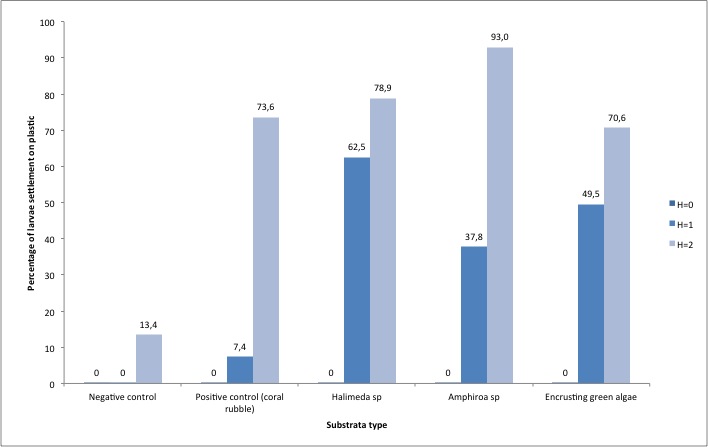Larvae Settlement
Experiment
Introduction
As adult ascidians are sedentary, they rely entirely on their larvae to settle in a suitable location. For that, larvae use different chemical and physical cues in their environment, such as the presence of conspecific or the absence of light. As the competency time of Ascidia glabra was not known, the first part of this study aimed to determine it by assessing settlement percentages of A. glabra larvae every hour. In the second part of the experiment, larvae substrata preferences for settlement were measured.
Methods
Competency assessment
Ten (10) larvae were put in each plate filled in with 5mL of sea water. Three (3) plates were kept with only sea water and larvae as a negative control whereas coral rubble pieces (from which the adult ascidians were collected) were put in three (3) other plates at H0. Coral rubbles were also put in three (3) plates at H2. Settled larvae were counted and recorded on each plate every hour to assess competency.
Settlement preference assay
Five (5) treatments were set for the settlement preference assay with three (3) replicates for each treatment. The first treatment was the negative control, i.e. plates containing only the 5mL of sea water and ten (10) larvae. The second treatment was the positive control, i.e. plates containing 5mL of sea water, pieces of coral rubble and larvae. The third treatment included sea water, larvae and pieces of the foliose green algae Halimeda discoidea. The forth treatment included sea water, larvae and pieces of the branching crustose algae from Amphiroa sp.. Finally, the last treatment included sea water, larvae and pieces of encrusting green algae (undetermined species).
Settlement percentages were calculated at H0, H1 and H2 for each treatment.
Results
Competency assessment
 Figure 1: Settlement percentage in function of time with chemical cues added at different time
Figure 1: Settlement percentage in function of time with chemical cues added at different time
The settlement was faster and occurring at a higher percentage when the cue was added at H0 than in the control. When the cue was added at H2, the settlement was almost immediate.
Settlement preference assay
 Figure 2: Percentage of Ascidia glabra larvae settlement in response to different substrata
Figure 2: Percentage of Ascidia glabra larvae settlement in response to different substrata
Only the coral rubbles and the encrusting green algae substrata induced a significant settlement at the right place (i.e. on the substrata), with a faster settlement on coral rubbles (Figure 2). It was also observed that the settlement occurred only on the dark side of the substrata.
 Figure 3: Percentage of Ascidia glabra settlement on plastic in response to different substrata
Figure 3: Percentage of Ascidia glabra settlement on plastic in response to different substrata
It was also interesting to notice that the substrata which did not induce any significant viable settlement still induced settlement on the plastic of the plate (Figure 3).
Discussion
Competency assessment
Competency is achieved when more than 50% of the larvae are settled. In A. glabra, competency was achieved around 85 minutes post-hatching when a cue was present since the hatching (Figure 1). By adding a cue at H2, it was made sure that the larvae would still be competent and settle some time after they reached competency in the first place (no loss of the competency because of degenerescence).
Settlement preference assay
All larvae settling on the substrata were found on the lower side of the substrata piece, i.e. on the darker side. It was previously described that almost all ascidian larvae seem to possess photoreceptors and to be photonegative during the settlement and A. glabra seems to follow this trend (Svane & Young, 1989; Crisp & Ghobashy, 1971).
Only two treatments induced a settlement on substrata significant enough (about 15%): the coral rubbles and the encrusting green algae. From this result, it can be thought that this encrusting green algae probably act as a cue for A. glabra settlement. Unfortunately, identification of this algae was unsuccessful. Further study could aim to identify the algae species used in this study and define more specifically its role in A. glabra settlement.
It should also be noted that Halimeda sp and Amphiroa sp induced high percentages of larvae settlement on plastic (78,9% and 93,0% respectively). This can be due mainly to two reasons: either the larvae were rightly cued to settle and they could not find the substrata to settle on or they were cued to settle far from these substrata.
|